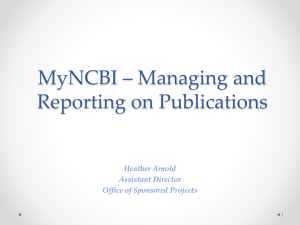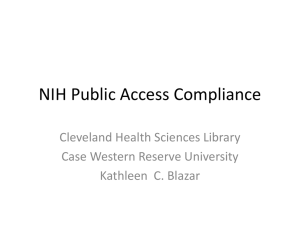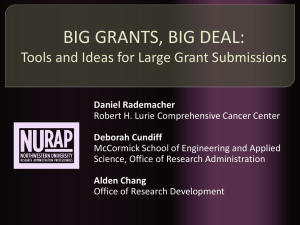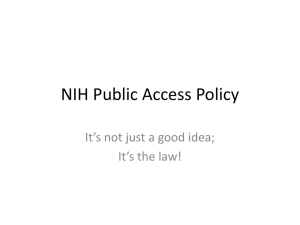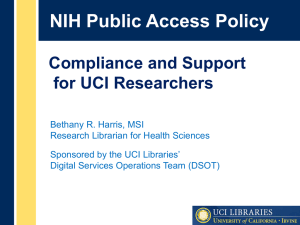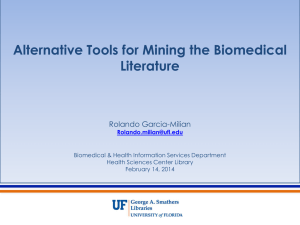NIH Public Access Compliance - Case Western Reserve University
advertisement
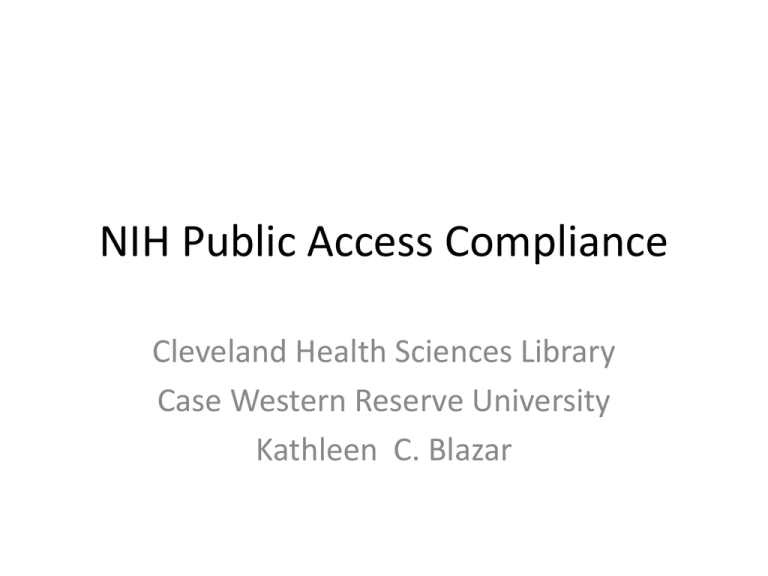
NIH Public Access Compliance Cleveland Health Sciences Library Case Western Reserve University Kathleen C. Blazar NIH Public Access Homepage The law states: • The Director of the National Institutes of Health shall require that all investigators funded by the NIH submit or have submitted for them to the National Library of Medicine’s PubMed Central an electronic version of their final, peer-reviewed manuscripts upon acceptance for publication, to be made publicly available no later than 12 months after the official date of publication: Provided, That the NIH shall implement the public access policy in a manner consistent with copyright law. Available from http://publicaccess.nih.gov/policy.htm Applicability • Peer-reviewed journal publications – No abstracts, no proceedings if not peer-reviewed, no editorials, no letters, no review articles, no book chapters • Accepted after April 7, 2008 • Any NIH grant • PI does not need to be an author, but if the PI’s grant is cited, the PI is responsible • Grant numbers are supplied by the publisher, or, • Papers are listed on progress reports • PMCIDs must always be included in NIH correspondence Copyright • Before you sign a publication agreement or similar copyright transfer agreement, make sure that the agreement allows the paper to be posted to PubMed Central (PMC) in accordance with the NIH Public Access Policy. Final, peer-reviewed manuscripts must be posted to the NIHMS upon acceptance for publication, and be made publicly available on PMC no later than 12 months after the official date of publication. Available from http://publicaccess.nih.gov/address_copyright.htm Submission Methods • Method A Journal deposits final published articles in PubMed Central without author involvement • Method B Author asks publisher to deposit specific final published article in PMC • Method C Author deposits final peer-reviewed manuscript in PMC via the NIHMS • Method D Author completes submission of final peerreviewed manuscript deposited by publisher in the NIHMS Publishers information • Most publishers’ web sites maintain information about NIH Compliance • Look at the information for authors • Some of the current policies did not exist a few years ago PubMed or PubMed Central PubMed • PubMed comprises more than 23 million citations for biomedical literature from MEDLINE, life science journals, and online books. Citations may include links to full-text content from PubMed Central and publisher web sites. PubMed Central • PMC is a free full-text archive of biomedical and life sciences journal literature at the U.S. National Institutes of Health's National Library of Medicine (NIH/NLM). PMID/PMCID PMID from PubMed • The accession number in the database of citations to the literature – refers to an entry which may have other links to full text elsewhere • Not an indication that the full text of an article is available at NIH PMCID from PubMed Central • The accession number to the full text article on the NIH server known as PubMed Central. • Someone made a concerted effort to upload the article to this repository – the author, the publisher - Open Access • Open-access (OA) literature is digital, online, free of charge, and free of most copyright and licensing restrictions • Available from http://www.earlham.edu/~peters/fos/overvie w.htm NIH’s Public Access • The Public Access Policy ensures that the public has access to the published results of NIH-funded research. It requires scientists to submit final peer-reviewed journal manuscripts that arise from NIH funds to the digital archive PubMed Central (http://www.ncbi.nlm.nih.gov/pmc/). The Policy requires that these final peer-reviewed manuscripts be accessible to the public on PubMed Central to help advance science and improve human health. • Available from http://publicaccess.nih.gov/FAQ.htm My NCBI and My Bibliography • My NCBI is a tool that retains user information and database preferences to provide customized services for many NCBI databases. It allows you to save searches, select display formats, filtering options, and set up automatic searches that are sent by e-mail. My NCBI users can save their citations (journal articles, books, meetings, patents and presentations) in My Bibliography and manage peer review article compliance with the NIH Public Access Policy. My NCBI includes additional features that allow for setting up preferences for displaying and filtering search results, highlighting search terms and setting LinkOut, Outside Tool and Document Delivery preferences. • Available from http://www.ncbi.nlm.nih.gov/books/NBK3842/ My Bibliography • 2010 - required for eRA Commons users • 2012 – automatically updates to include citations associated to grants • 2013 – create PDF reports for paper progress reports • 2013 – SciENCV to create online personal profile My Bibliography - My NCBI Help - NCBI Bookshelf http://www.ncbi.nlm.nih.gov/books/NBK53595/ Look for the section on compliance: http://www.ncbi.nlm.nih.gov/boo ks/NBK53595/#mybibliography.Ma naging_Compliance_to_th Compliance Statuses My Bibliography • • • • • • • Use eRA Commons login Manage My Bibliography Add citations from PubMed Add citations manually for other materials From AWARD display, associate funding Create Award Compliance Report - PDF Share and delegate So, what are you going to do? • Apply for grant – bib. must have all authors, all PMCIDs, URLs of free full text • Get grant! –YAY!!! • Do research • Publish results in peer-reviewed journal • Be sure manuscript is submitted to PubMed Central • Put citation in My Bibliography and associate with award(s) • Always include PMCIDs with NIH correspondence Cleveland Health Sciences Library hclref@case.edu


